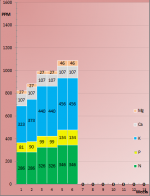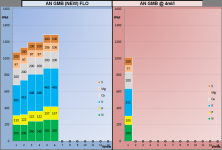It's good to hear you like those chart's guys.
It's also possible to compare full schedules (with different NPK-s for every week) with the spreadsheet, there are also graphs for most of the common growshop fertilizers like AN, Canna, GH, FF, etc with all of their feeding schedules dialed in.
For example this is AN's feeding schedule for the Blooming phase using Sensi 2 part, Hobbyist level.
Feeding schedule link
Numbers for Sensi A and B are based on a Lab analysis found here, additives are based on their labels.

Lots of P in there.
YosemiteSam
Could you drop custom hydro a mail to clear that up? It's still possible that I made the mistake, but I don't know where.
spurr
I will be glad to make new charts for you.
It's also possible to compare full schedules (with different NPK-s for every week) with the spreadsheet, there are also graphs for most of the common growshop fertilizers like AN, Canna, GH, FF, etc with all of their feeding schedules dialed in.
For example this is AN's feeding schedule for the Blooming phase using Sensi 2 part, Hobbyist level.
Feeding schedule link
Numbers for Sensi A and B are based on a Lab analysis found here, additives are based on their labels.
Lots of P in there.
YosemiteSam
Could you drop custom hydro a mail to clear that up? It's still possible that I made the mistake, but I don't know where.
spurr
I will be glad to make new charts for you.








